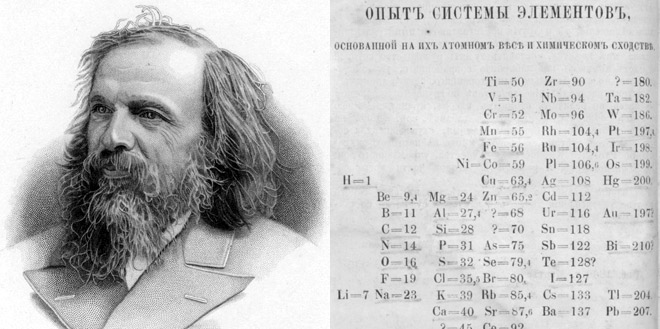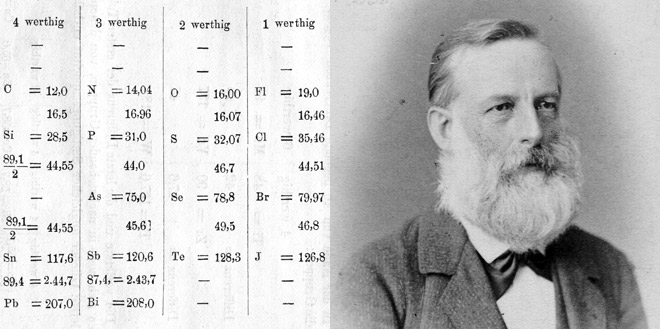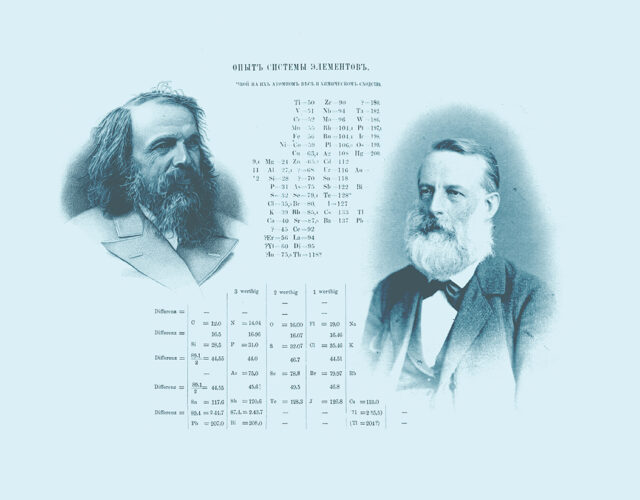In the mid-19th century in much of Europe, Britain, and the United States, the names of progress were technology, trade, and human liberty. The not-yet-unified German states were growing into competitors to the traditional scientific powerhouses of France and Britain. Even Russia began to bend to the winds of change despite being an autocratic, largely agricultural society where serfs were bound to the land they worked and government censorship was the norm.
Two young men began their professional journeys at this time. In 1850 a teenager from Siberia began to study chemistry in St. Petersburg, the Russian capital. In the 1860s the now-citified provincial became a civil servant in the tsar’s government. He was a devoted teacher, aware of the lack of good textbooks in Russian. At age 35, to make the lives of his students easier, he wrote a chemistry textbook in his native language that contained a simple table categorizing the elements.
Meanwhile the other man, a German, studied medicine in Switzerland and then chemistry in the German states under two of that region’s great scientists: Robert Bunsen and Gustav Kirchhoff. He too became a teacher, shifting between various German universities, and wrote chemistry textbooks, the first of which contained a simple table categorizing the elements.

Both men are now important names in the history of science: Dmitri Mendeleev and Julius Lothar Meyer. Each man created a periodic system of the elements. And while Meyer’s first version of his table appeared in 1864 and Mendeleev’s not until 1869, it is Mendeleev who has become widely known as the single parent of the periodic table. But this is not a story of injustice, of a man who never received his due. Instead it reveals the changing nature of chemistry. What follows is a tale that undermines our expectations of what and who makes a great scientist and hangs as much on language as on science.
Two Chemists
At age 15 Mendeleev emerged from Tobolsk, the old capital of Siberia, a most unusual place to find a budding chemist. His mother, in search of opportunities for her bright son, took him to St. Petersburg for his education, where he pursued the sciences, especially chemistry. After a miserable two years teaching uninterested high-school students in Crimea, Mendeleev wrangled a government-subsidized postdoctoral position that took him to Heidelberg.
Meyer, unlike Mendeleev, came from a scientifically inclined family. Meyer worked as a gardener when migraines forced him out of high school for a time. Afterward he followed the standard path for Germans intent on becoming professors, deviating only a little in the breadth of his chemical interests and in the number of places at which he studied: Zurich for general chemistry and the German states for physiological chemistry, physical chemistry, and physics.
Meyer’s education exposed him to more theoretical speculations than were usual for a chemist, certainly more than Mendeleev experienced, but to an outside observer he followed the itinerant and slightly dull university-bound life of a man establishing himself as a professor in Germany. Mendeleev, however, followed anything but a predictable path for a professor of chemistry. He was forced to make a place for himself among the long-established elites of St. Petersburg, where he spent the rest of his life. Mendeleev taught chemistry, published much, became skilled in public relations, and presented himself as a general-purpose intellectual on scientific topics, including oil production, agriculture, and even cheese making. Far more is known about Mendeleev than Meyer (the former kept all his notes, records, and letters dating from the first inklings of his periodic system’s potential).
The tsar’s emancipation of the serfs in 1861 led to rapid urbanization and the beginnings of an industrial revolution as ex-serfs, who made up 80% of Russia’s population, moved to cities in search of economic opportunities. Russia was feeling the early tremors of a seismic cultural shift that would precipitate its transition from an agricultural to an industrial nation. These changes offered opportunities to a man of Mendeleev’s temperament and skills. Mendeleev taught at St. Petersburg University, but he also advised the state on such science-related topics as tariffs on imported chemicals, parts for chemical factories, and the growing oil industry. Along with these economic transformations came political ones that led to a partial liberalization—although not democratization—of the state. Censorship of the press was eased, universities reformed, and education expanded to create a technical elite who would build the factories that would modernize a Russia that remained under the tsar’s control.
And that was the system Mendeleev liked. “He wanted the tsar to be firmly in control,” says historian Michael D. Gordin, author of A Well-Ordered Thing: Dmitrii Mendeleev and the Shadow of the Periodic Table. “He was pro-progress, pro-modernization, pro-liberalization of the economy. He was not pro-democracy. He saw the beginnings of parliament in 1905, and he didn’t like it.” Mendeleev wanted Russia to compete economically with Britain and Germany, or, as he put it in the last years of his life, “to catch up and overtake.”

In 1870, the year the German states merged to form one nation as a result of the Franco-Prussian War, Meyer was a chemistry professor at Karlsruhe Polytechnic Institute. He contributed his medical skills to his newly born nation by setting up a temporary hospital for those injured in the war. Like Mendeleev, he saw his world politically and economically transformed, but unlike Mendeleev, he was never part of public life. “He was a classic university professor,” says Gordin. “He taught large courses, advised lots of students, wrote textbooks, and lived a very bourgeois life.”
While Meyer’s life may have followed that of a bourgeois professor, in the chemistry world he was an oddball: he speculated, including on the physical reality of the atom and on how matter was built and bonded. Despite this, remarks Gordin, if you asked almost any 19th-century chemist which one of the two was more of a chemist’s chemist, it would be Meyer: “He does things properly. He’s a little funky on theory and has a lot of speculations, but he knows how to discipline and control them.”
In the 1860s the interests of both men coalesced around the periodic behavior of many of the known elements. Today we understand the periodic table as saying something fundamental about matter. Each row of the table moves from left to right as electron shells fill up; each element has one more proton than the one before it. But in the 1860s electrons had yet to be discovered, and only a few chemists, such as Meyer, were rash enough to speculate on the atom’s physical reality.
Making a Periodic Table
Systems to order the elements came into existence six times during the 1860s. Even before tables were created, people found relationships among elements, such as certain triads where the atomic weight of the middle element is the average of the ones on either side. And it was clear to chemists of the time that certain elements came in natural families, like the halogens—fluorine, chlorine, bromine, and iodine.
All the systems put the elements in order of increasing atomic weight, which is why they cluster in the 1860s. Before that time chemists did not have accurate atomic weights; some were off by a factor of two, being measured as twice as heavy or twice as light as what we now recognize as their true weights. Uranium, for example, was thought to weigh something on the order of 120, instead of 240. Only after the first major international chemistry conference, held in Karlsruhe in 1860 and attended by both Meyer and Mendeleev, did chemists standardize atomic weights. Once that happened, chemists found it far easier to order their elements.
A French mining engineer named Alexandre-Émile Béguyer de Chancourtois created the very first system of ele-ments in 1862. Instead of the now-familiar grid, he used a helix and called his system the telluric screw: Béguyer de Chancourtois drew a diagonal line on a sheet of graph paper and placed the elements along the line by increasing atomic weights, then wrapped his sheet around a cylinder. Dropping a vertical line down the sheet linked elements with similar properties. “There were experimental errors and not all the elements sit on a straight line, but it’s a very interesting system,” says Gordin. “But no one cared; no one even remembered what he did until the 1870s, when there was a priority dispute over the periodic table.”
In 1864 Meyer published the first edition of Die modernen Theorien der Chemie and included a table of 28 elements arranged by increasing atomic weight and divided into six families by valence. So, for example, sulfur was placed just below oxygen in the valence-2 column (valence determined how elements combined with each other). Tin was placed below silicon in the valence-4 column, though intriguingly Meyer left a gap between silicon and tin, as if for a shadow element. “Meyer’s distinctive quality for most historians and chemists is that he had gaps [in his periodic system] and chose not to predict,” says Gordin. “And, therefore, he somehow failed because predicting is obviously what you should do when you have gaps in a system.” But in the 1860s filling the gaps was not at all an obvious move.
Mendeleev also encountered gaps when assembling his first table in 1869—three gaps, to be precise, each of which he filled with a question mark and rough estimate of atomic weight before moving on to the next element. Mendeelev viewed his system as a generalization about matter rather than an earth-shattering invention. It allowed chemists, especially those teaching students, to organize large amounts of information in a small amount of space. In essence it was a teaching tool with no connection to theory. Mendeleev initially developed the table for his textbook Osnovy khimii (Principles of Chemistry). When it came time to present it to the Russian Chemical Society in March 1869, Mendeleev was off in the countryside inspecting cheese makers, leaving a friend to introduce his table to the world.
In an article published in a Russian chemical journal the following month, Mendeleev compared his system to the others he knew about. He believed his system offered eight advantages over competing systems; the possibility of discovering unknown bodies was only a minor one and came second to last in the list. Only in 1870 did he begin to offer detailed predictions—his eka elements—to fill three gaps in the 63 then-known elements.
Meyer’s theoretical daring allowed him to speculate about real, physical atoms but not to predict the existence of a new element. While he did not discount the existence of new elements, he, like other scientists, saw no reason to assume that any gap must be filled with an unknown or even unknowable element. Chemists at the time understood their jobs as explaining substances that already existed. On the other hand, Mendeleev, the filler of gaps, refused for many years to believe in the existence of the atom, hated the idea of radioactivity from the time it was discovered in 1895, and rejected the electron after J. J. Thomson found it in 1897. In addition, some of his elemental predictions were wrong, including one for an element he called Newtonium (see sidebar).
The question of who “discovered” the periodic table first then depends on what people think has been discovered. Says Gordin, “It’s not like, ‘I found this coffee cup first.’ It’s which relationships [that our current periodic table predicts] matter most.” Meyer left gaps. But Mendeleev was the one to say those gaps should be filled. It’s a weird assumption, says Gordin, because no one knew about electrons and protons and neutrons.
A Missed Step
In 1869 censors allowed the publication of the first chemical journal in the Russian language: the Journal of the Russian Chemical Society. But censorship was not the only reason for a lack of Russian science journals. At the time there were about 200 academic physical scientists in the whole of Russia; Berlin, soon to be Germany’s scientific capital, had several times that number.
Mendeleev wrote his textbook, which included his table, in Russian and intended it for Russian college students. Few Russian professional chemists and no chemists outside of Russia would have read it. But Mendeleev also published his table in the first volume of the Journal of the Russian Chemical Society, describing it as a wonderful teaching tool with the added benefit of a few interesting predictions.
“Mendeleev wanted to publish in Russian because he was patriotic and because he was more comfortable in it,” Gordin says. “At the same time, he knew that he wouldn’t get any credit abroad, and credit abroad was very useful for credit at home.” At this time Italian had faded as a language of science, leaving the field to English, French, and German. Russians looking for scientific credit beyond their own borders tended to publish in German or, more rarely, French. Says Gordin, “No chemist in Europe—Italy, France, Germany, Scandinavia, or Britain—read Russian. So if you published it in Russian, it was functionally unpublished. No one would know; it’d have no impact.”
Mendeleev spoke German but wrote that language only haltingly. After he reduced his 10-page article into a one-page abstract, he gave it to a local bilingual professor to translate into German. The professor passed it to a graduate student who quickly translated the abstract; it was published in 1869 in a minor German journal named Zeitschrift für Chemie und Pharmacie, one favored by Russian chemists. Any Germans who wanted to keep track of what Russian chemists were up to read that journal.
Mendeleev understood the need for speed in publishing; coming second counts for little in assigning credit. Unfortunately the translator missed what we now consider to be Mendeleev’s central claim. “There’s a slight mistake in the translation,” says Gordin. “Instead of saying that if you organize elements according to their atomic weight, there is a periodic change in their properties, which is what Mendeleev said in the Russian, the German version says, ‘There is a gradual or a stepwise [stufenweise] change in the property.’ There’s a very easy one-to-one word translation, periodicheski in Russian to periodische in German, but the translator didn’t think it was that important a word.”
Meyer read Mendeleev’s German abstract, and when in 1870 he published his full periodic system in Liebigs Annalen der Chemie, then possibly the world’s most significant chemistry journal, he cited Mendeleev profusely. Meyer added that Mendeleev had almost reached his goal but hadn’t understood that the system was periodic.
Gordin reimagines the response and counter-response: “Mendeleev says, ‘But I said it was periodic,’ and Meyer says, ‘No you didn’t. You said it was stufenweise; you said it was gradual.’ Mendeleev goes, ‘Oh, that was the German abstract. That wasn’t the Russian original. You should have looked at the original.’ And Meyer says, ‘I’m not supposed to read Russian. That’s too much to expect from me. I already have to read Italian and French and English and Swedish!’”
The one-word difference, the shift from “periodic” to “stepwise” triggered a heated dispute between the two men that ran throughout much of the 1870s and which was extensively commented on in chemistry journals across Europe. Mendeleev knew he had to persuade the Germans, who by that time were preeminent in chemistry. In 1871 he published the full version of his work—with now detailed predictions of three new elements—in Liebigs Annalen. The battle heated up in the journal of Germany’s new chemical society, Berichte der deutschen chemischen Gesellschaft.
Mendeleev stood fast in refusing to give Meyer any credit. “Meyer’s claims for credit were modest,” Gordin says. “He wanted some credit for being part of the process of creating a periodic system. Mendeleev wanted credit for creating the system; he didn’t think he should share that with anybody. And it’s very tricky to claim that because there were so many predecessors.”
A Russian Triumph
In his fight with Meyer, Mendeleev argued that his periodic system was independent of and more advanced than anybody else’s. And he took what no one else had done, his predictions, and emphasized those, staking his claim to priority on what he called his eka-elements: eka-aluminum, eka-boron, and eka-silicon, which filled the gaps next to aluminum, boron, and silicon. Eka-aluminum was discovered in 1875 and called gallium; in 1879 eka-boron was discovered and called scandium; and eka-silicon was discovered in 1886 and called germanium. Mendeleev had expected his predictions to come true at some uncertain future date, with any luck while he was still alive. When the first of his predictions came true, Mendeleev, says Gordin, was as surprised as anyone else.
But simply predicting new elements was not enough; Mendeleev had to convince people that prediction was the important criterion in deciding who won the race. By the 1880s he had persuaded the world that prediction made the periodic system a unique chemical tool. Even so, chemists often gave Meyer and Mendeleev shared credit for the periodic system, with each discovering it independently. Meyer and Mendeleev jointly received the Davy Medal of the Royal Society in 1882. Chemistry textbooks published at the turn of the 20th century that included the periodic table often mentioned Meyer as well as Mendeleev as the creators of the periodic system.
Only death ended the priority battle. After Meyer died in 1895, Mendeleev, who died in 1907, continued to write about the priority dispute, claiming sole ownership of the periodic system, and without Meyer few were left to argue against him. The Soviet Union’s growing economic importance in the 1930s helped tip the balance further, as did the Nazi purge of German science and their expulsion of Jews, socialists, and other undesirable scientists. By the 1950s the Soviet Union was second only to the United States in terms of quantity and quality of work in chemistry, and Soviet chemistry journals referred to the periodic table as Mendeleev’s system of chemical elements. Mendeleev had become the undisputed father of the periodic table.
Mendeleev after the Periodic Table
The periodic table became truly central to chemistry only after World War I, at least in part owing to the rise of the Bohr atom with its central proton nucleus surrounded by orbiting electrons. For the first time the periodic system could explain why the elements have the properties they do. Ironically, given this later importance of the electron to the periodic table, Mendeleev rejected the existence of electrons. He was also skeptical of the noble gases when they were discovered in the 1890s because they did not form bonds with other elements and so had no place in his table. Mendeleev only accepted the noble gases as a way to explain away radioactivity, which he rejected because he believed matter to be immutable.
After developing his periodic system Mendeleev moved into gas physics in search of ether and its composition. Ether was the holy grail of the physical sciences in the second half of the 19th century, and almost all scientists accepted its existence. Since ether was assumed to have mass, Mendeleev was determined to find it and place it in his periodic table among the noble gases. Not only would ether have a place at his table, he also could use it to ensure that the atom remained unbroken—no need for radioactivity or pesky electrons. Any supposed breakdown of atoms could be explained away by the emission of ether, which Mendeleev calculated to be a million times lighter than hydrogen. Some of Mendeleev’s published tables left space for ether and marked that spot with an X. He called element X Newtonium.
This feature is based on a lengthy interview with Michael D. Gordin, professor of history at Princeton University, about his past and current work in the history of science.




